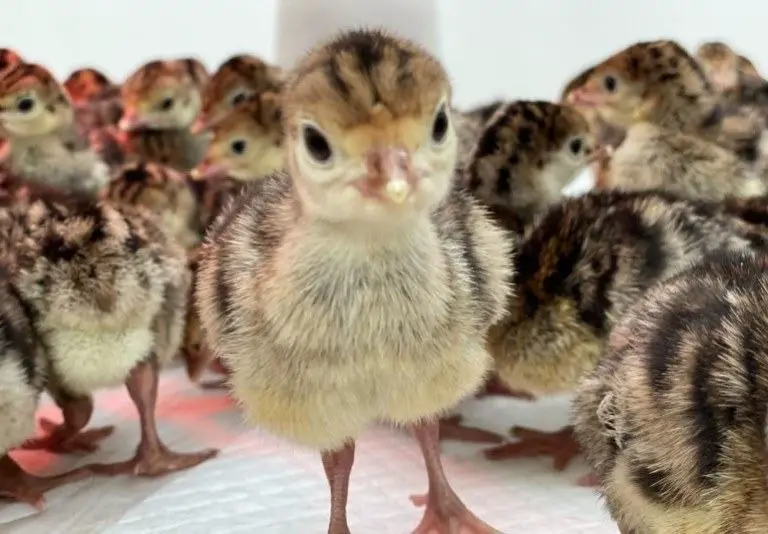No products in the cart.
Turkey
Baby Turkey A-Z: How To Raise, Feed & More!
Turkeys are among the most common birds in North America, so common that Benjamin Franklin wanted to make them the national bird of the USA rather than the Bald Eagles. However, even farmers and ranchers know little about baby turkey.
This article will give you in-depth knowledge about turkey poult, such as baby turkey care, baby turkey food, and so on.
*This post may have affiliate links, which means I may receive commissions if you choose to purchase through links I provide (at no extra cost to you). As an Amazon Associate I earn from qualifying purchases. Please read my disclaimer for additional details.
Baby Turkey Name
Are baby turkeys called chicks?
Generally speaking, chicks are more commonly used for baby chickens and baby turkeys have a more specific name. That being said, many people still call baby turkeys chicks and it is acceptable.
What’s a baby turkey called?
During the first 28 days after hatching, baby turkeys are called “poults”. A baby female turkey is called “jenny” and a baby male one is called “jake”.
During this period, poults should be guided and protected by their mothers, as they are still too weak and easily become the prey of predators.
Read more: What to feed baby chicks after hatching?
Baby Turkey Color
Are they white or yellow?
Normally, newborn birds are brown, grey, mottled, or white. However, most baby turkeys are yellow, especially domesticated ones. For the wild poults, they are partly yellow.
Of course, there are particular cases that newborn poults do not have any yellow pattern on their bodies, but overall, yellow one is more common to see.
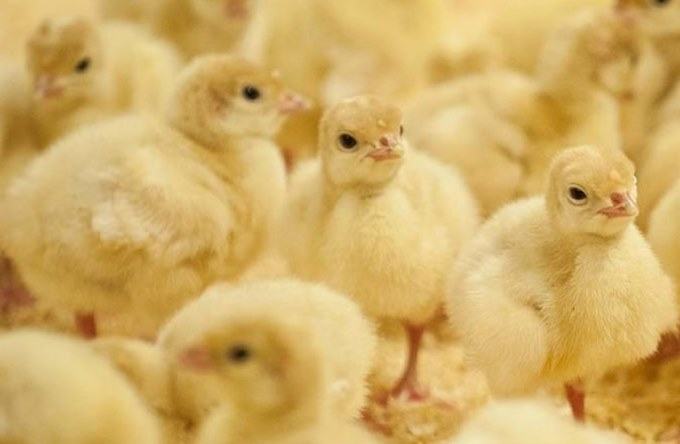
Read our related article where we review the Best Turkey Egg Incubator on the market today!
Baby Turkey Sex
At what age can you tell if a turkey is male or female?
You can figure out the baby turkey gender at the time it is 3 weeks old. At that time, a jake (male baby turkey) starts strutting while a female turkey does not strut.
The jakes will begin to fan the feathers at their tail, drop the wings, and show all the feathers in the contour so that their bodies can appear to be larger. They may also keep their heads close to the bodies and stay upright to the front.
If you catch this sight, you can rest assured that it is a male turkey. As the jakes are several weeks older, you will see their tails and heads turn bright red with some sparks of blue and even burgundy as they strut.
Can you tell the gender of a turkey by its poop?
The answer is a surprising YES, you can tell a turkey’s gender by its droppings. Male turkeys produce spiral-shaped poop while female turkeys’ droppings are shaped similar to the letter J.
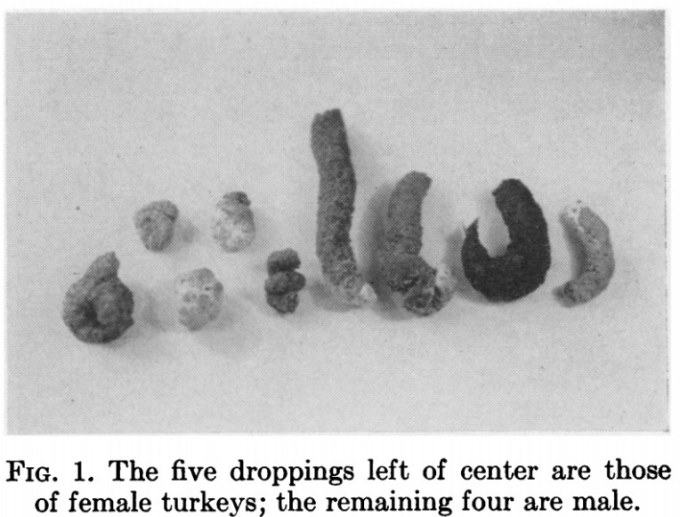
Read More: How Often Do Canada Geese Poop? It’s a lot!
Baby turkey care
Do baby turkeys need a heat lamp?
Turkeys are small, thermophilic birds, therefore a heat lamp is essential for baby turkeys. The incubator’s temperature should be set from 95° to 98°F before the poults are placed inside.
You should pay close attention to their behavior in the incubator. If they are cowering under the light, it means they are cold. If they are trying to stay away from the center, they are too hot. If they are acting normally under the light, it means the temperature is perfect.
The temperature should be lowered by 5°F per week until the temperature outside is the same as inside the brooder. To do that you just need to raise the heat lamp higher.
Do not let the poults get wet or cold. Adequate airflow is allowed, but no drafts inside the incubator.
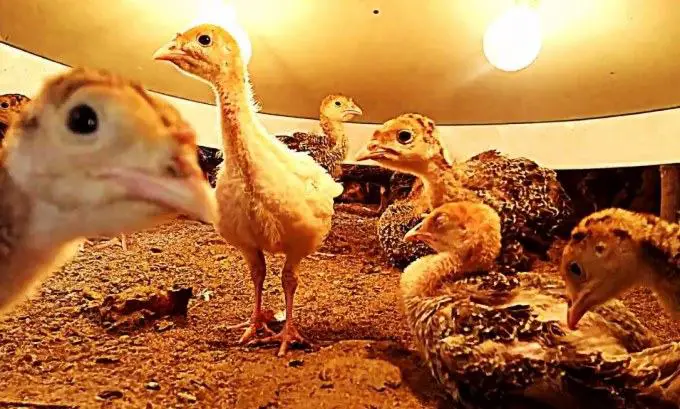
Read our related article on How to Raise Turkeys and Chickens Together for more poultry tips and tricks!
How long do they stay with their mother?
Baby turkeys should stay with their mother for at least 8 weeks after hatching. They easily get cold when their feather is not fully grown yet. Therefore, they need to have a fully-groomed feather before living outside, and that happens when they reach 8 weeks old.
If the outside temperature is too cold, you should postpone their outdoor experience. In that situation, a heat lamp will be necessary to keep them dry and warm at night.
Where do they sleep at night?
Wild baby turkeys sleep under the mother turkey’s wings on the ground during their first few weeks. About one month later, they will join their parents sleeping on a low branch at night, snuggling under their parents’ wings.
Read More: How to Care for Quail Babies. Caring for chicks may seem difficult, but it’s easier than you think! Here’s a complete guide to caring for quail chicks.
Raising Baby Turkey
Are they hard to raise?
Comparing to ducks and chickens, raising turkeys is a lot more challenging because they are more sensitive and fragile to nutritional and environmental mismanagement.
Therefore, you must guarantee their sanitation, food, and disease prevention if you want your baby turkeys to develop safely.
In addition, turkeys live with their flock, so you cannot raise just one. You can have your turkeys housed with chickens, but you need to guarantee the chickens’ sanitation as they can carry diseases that are harmful to your turkeys.
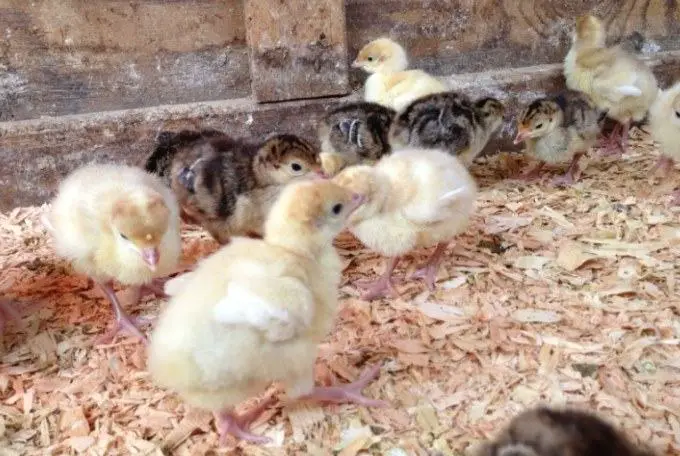
How to raise baby turkeys?
First of all, they love the heat. Therefore, you should guarantee that your poults are warm enough by using a heat lamp in their coop as we mentioned above.
Second, make sure that your poults are dry and clean. Pine bark or rice husks are ideal for their bedding. Also, make sure that you never give them cold water.
Last but not least, turkeys need more protein than chickens. Baby turkeys will need 28% of the starter protein for their first 6 to 8 weeks. We recommend that you look for turkey or wild bird specialized food.
Read More: What Do Baby Geese Look Like When They Hatch? This complete guide covers fuzzy goslings!
Baby Turkey Food
What to feed?
You can use this feeding schedule for your poults:
- First 8 weeks: Feed them a starter of 28% protein.
- 8 weeks – 6 months: 24-26% crushed protein grower for turkey.
- 6 months and above: 16-18% crumbles, layer pellets, or mash.
Regarding baby turkey food, greens, bread, garden trimmings, and scratch are ideal for snacks, but they should be limited. If your poults are fed with this too much, they will be too full and cannot eat nutritious meals.
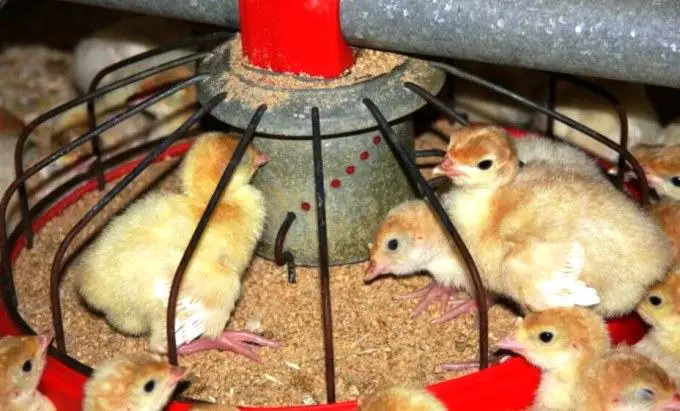
Can they eat bananas?
They really enjoy small pieces of banana as a snack. Besides bananas, they also like some bread, grapes, raisins, and acorns.
Read More: Can Chickens Eat Grapes With Seeds? Grapes are great for turkeys. Find out if chickens can have them, too!
What not to feed?
Here are a few things that you should NOT feed your poults:
- Forms of calcium such as oyster shells, breeder mash, and chicken layer pellets: high level of calcium can cause your poults diseases related to bone, liver, and kidney.
- Rhubarb leaves, potato peels, avocados: these can be toxic if consuming too much.
- Scratch: this should not be fed to your poults before they get 8 weeks old.
Notices on other Baby turkey problems
One of the most common problems of turkey poults is lethargic, flustered skin with droopy wings and blood in droppings. This might be caused by coccidiosis, a type of protozoan that is contagious.
Antibiotics will not cure it completely – only sulfa drugs like Sulmet will. Preventing this common illness through good sanitation is advisable.
Also, poults should be kept separately from the adults. As they mature, they will have a natural immunity to coccidiosis.
You will also find that young turkeys are often addicted to picking newly grown feathers. Causes of this include overheating, overcrowding, not enough protein, too much light, and so on. This must be stopped as soon as possible because this bad habit can be hard to give up.
Why do my baby turkeys chirp so much?
There are many reasons for this matter. If your poults chirp so loudly and frequently, the temperature may be uncomfortable to them. Therefore, make sure they are comfortably warm, neither too cold nor too hot.
Another reason may be they are chirping for food and water. You should ascertain that your poults are accessible to food and water anytime. The containers should not turn upside down at night by any chance.
Last but not least, your poults may chirp because they are uncomfortable or in pain. Their immune system is still weak and they can easily get sick. Therefore, you should guarantee sanitary as well as nourishing their physical and mental health.
Read More: What is a Good Food Plot for Turkey? Give your turkeys variety or attract wild turkeys with these favorite food plots!
Bottom lines
To sum up, there are a lot of things to bear in mind when raising a baby turkey. Raising and taking care of them is rather challenging and requires lots of effort. Therefore, we hope you have learned some useful knowledge that will assist you in the journey of becoming a good rancher after reading our article.
